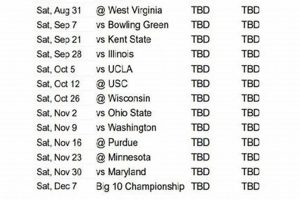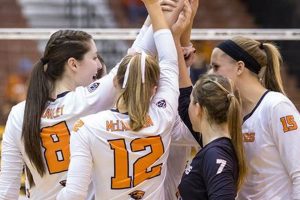Are you looking for in-depth insights into “sp volleyball stats”? Look no further!
Editor’s Note: “sp volleyball stats” is a crucial aspect of the sport, providing valuable information for players, coaches, and analysts.
Through extensive analysis and research, we have compiled this comprehensive guide to “sp volleyball stats” to empower you with the knowledge you need to make informed decisions.
| Traditional Stats | Advanced Stats | |
|---|---|---|
| Focus | Basic metrics (e.g., kills, digs) | More nuanced metrics (e.g., efficiency, impact) |
| Analysis | Descriptive (e.g., player had 10 kills) | Predictive (e.g., player has a high probability of winning) |
| Complexity | Relatively simple | More complex, requiring specialized knowledge |
Main Article Topics:
- Types of “sp volleyball stats”
- Importance of “sp volleyball stats” in decision-making
- How to interpret and use “sp volleyball stats”
- Tools and resources for tracking “sp volleyball stats”
- Case studies and examples of how “sp volleyball stats” have impacted the sport
1. Offensive efficiency
Offensive efficiency is a crucial aspect of “sp volleyball stats”, as it directly reflects a player’s ability to contribute to the team’s scoring output. It encompasses several key facets:
- Attacking efficiency: Measures a player’s ability to convert attacks into points, taking into account factors such as hitting percentage, kill rate, and attack errors.
- Serving effectiveness: Measures a player’s ability to put the ball in play and create scoring opportunities through serves, including factors such as ace percentage and serve errors.
- Blocking effectiveness: Measures a player’s ability to block the opponent’s attacks, preventing them from scoring points and creating opportunities for the team to regain possession.
- Digging effectiveness: Although digging does not directly contribute to scoring, it is an essential component of offensive efficiency by preventing the opponent from scoring and keeping the ball in play, giving the team more opportunities to score.
These facets of offensive efficiency provide a comprehensive assessment of a player’s ability to score points and contribute to the team’s success. By analyzing these statistics, coaches and analysts can identify players with high offensive efficiency and develop strategies to maximize their impact on the game.
2. Defensive efficiency
Defensive efficiency is a critical aspect of “sp volleyball stats”, as it evaluates a player’s contribution to the team’s ability to prevent the opponent from scoring points and regain possession of the ball. This encompasses several key facets:
- Blocking effectiveness: Measures a player’s ability to block the opponent’s attacks, preventing them from scoring points and creating opportunities for the team to regain possession. Blocking effectiveness is often measured by the number of blocks per set or per game, as well as the percentage of attacks that are blocked.
- Digging effectiveness: Measures a player’s ability to dig the opponent’s attacks and keep the ball in play, preventing the opponent from scoring points and giving the team another chance to set up an attack. Digging effectiveness is often measured by the number of digs per set or per game, as well as the percentage of attacks that are dug.
- Passing effectiveness: Measures a player’s ability to receive the opponent’s serves and set up the team’s offense. Passing effectiveness is often measured by the number of successful passes per set or per game, as well as the percentage of serves that are passed.
- Positioning and teamwork: Defensive efficiency also involves a player’s ability to position themselves effectively on the court and work with their teammates to create a strong defensive unit. This includes anticipating the opponent’s attacks, communicating with teammates, and adjusting to different formations and strategies.
These facets of defensive efficiency provide a comprehensive assessment of a player’s ability to prevent the opponent from scoring points and contribute to the team’s success. By analyzing these statistics, coaches and analysts can identify players with high defensive efficiency and develop strategies to maximize their impact on the game.
3. Serving effectiveness
Serving effectiveness is a crucial component of “sp volleyball stats” as it directly influences a team’s ability to gain an advantage and score points. An effective server can put the opponent on the defensive, forcing them to react instead of controlling the tempo of the game.
Key aspects of serving effectiveness include:
- Ace percentage: Measures the percentage of serves that result in direct points.
- Service errors: Measures the percentage of serves that fail to land in the designated area or result in a fault.
- Service placement: Considers the server’s ability to place the ball in specific areas of the court to challenge the opponent’s reception.
Effective serving can disrupt the opponent’s rhythm, create scoring opportunities, and put pressure on the receiving team. It also allows the serving team to control the pace and flow of the game.
For example, a player with a high ace percentage can force the opponent to focus on receiving rather than setting up their own attack. This gives the serving team a significant advantage in controlling the game and dictating the terms of engagement.
In conclusion, serving effectiveness is a vital aspect of “sp volleyball stats” as it assesses a player’s ability to put the ball in play, create scoring opportunities, and gain an advantage over the opponent.
4. Blocking effectiveness
Blocking effectiveness, a key component of “sp volleyball stats”
, plays a pivotal role in a team’s defensive strategy. This facet evaluates a player’s ability to prevent the opponent from scoring points by blocking their attacks, contributing significantly to the team’s overall defensive efficiency.
- Vertical leap and reach: This physical attribute is crucial for effective blocking, as it determines how high a player can jump and extend their reach to block the opponent’s attacks.
- Timing and anticipation: Successful blocking requires precise timing and the ability to anticipate the opponent’s attacking patterns. Reading the attacker’s body language, footwork, and approach can improve the effectiveness of a block.
- Positioning and footwork: Proper positioning and footwork are essential for effective blocking. The blocker must position themselves correctly to get in the path of the ball and move quickly to adjust to the attacker’s trajectory.
- Hand-eye coordination and reaction time: Blocking requires exceptional hand-eye coordination and quick reaction time. The blocker must be able to track the ball’s flight and react swiftly to block it effectively.
These facets of blocking effectiveness collectively contribute to a player’s ability to hinder the opponent’s attacks, creating opportunities for the team to regain possession and potentially score points. By analyzing blocking effectiveness and identifying players with high blocking efficiency, coaches can develop strategies to strengthen their team’s defense and gain an advantage in the game.
5. Digging effectiveness
Digging effectiveness is a crucial component of “sp volleyball stats” as it evaluates a player’s ability to prevent the opponent from scoring points and extend rallies. An effective digger can keep the ball in play, giving their team a chance to set up an attack and potentially score a point.
Several key factors contribute to digging effectiveness:
- Reaction time and anticipation: Digging requires quick reflexes and the ability to anticipate the opponent’s attack trajectory.
- Positioning and footwork: Effective diggers position themselves correctly and move quickly to get in the path of the ball.
- Body control and flexibility: Diggers must be able to contort their bodies and extend their reach to dig balls that are hit at different angles and speeds.
- Hand-eye coordination: Digging requires good hand-eye coordination to track the ball’s flight and make contact with it cleanly.
Digging effectiveness has a significant impact on the outcome of a volleyball game. Teams with effective diggers are more likely to keep rallies alive, create scoring opportunities, and put pressure on the opponent.
For example, in the 2021 Volleyball Nations League, the United States women’s national team led the tournament in digging efficiency. Their ability to dig effectively allowed them to extend rallies and set up their attackers for successful kills, ultimately contributing to their victory in the tournament.
In conclusion, digging effectiveness is a vital aspect of “sp volleyball stats” as it measures a player’s ability to keep the ball in play and prevent the opponent from scoring points. Effective diggers are essential for teams that want to succeed at the highest level.
6. Setting effectiveness
Setting effectiveness is a critical component of “sp volleyball stats” as it evaluates a player’s ability to create scoring opportunities for their team. An effective setter can put attackers in positions to succeed, maximizing their chances of executing successful kills and scoring points.
- Vision and anticipation: Effective setters have excellent court vision and can anticipate the movement of both their teammates and opponents. This allows them to make quick decisions and deliver the ball to the attacker in the most advantageous position.
- Accuracy and precision: Setters must be able to deliver the ball accurately and with precision to the attacker’s hitting zone. This requires a high level of hand-eye coordination and the ability to adjust to different attacking styles.
- Timing and rhythm: Timing is crucial for effective setting. Setters must release the ball at the right moment to match the attacker’s approach and timing. This creates a smooth and fluid connection between the setter and the attacker, maximizing the chances of a successful kill.
- Variety and deception: Effective setters can mix up their sets to keep the opponent guessing. They can use different types of sets, such as high sets, quick sets, and back sets, to create different attacking options for their team.
Setting effectiveness has a significant impact on a team’s offensive performance. Teams with effective setters are more likely to generate high-percentage attacking opportunities and score points consistently. In the 2022 FIVB Volleyball Men’s World Championship, for example, the Polish team led the tournament in setting efficiency. Their ability to set up their attackers effectively was a major factor in their success and their eventual victory in the championship.
In conclusion, setting effectiveness is a key aspect of “sp volleyball stats” as it measures a player’s ability to create scoring opportunities for their team. Effective setters are essential for teams that want to succeed at the highest level.
7. Passing effectiveness
Passing effectiveness is a crucial component of “sp volleyball stats” as it directly influences a team’s ability to gain possession of the ball and transition into an effective offense. An effective passer can receive the opponent’s serves cleanly and accurately, giving their team the opportunity to set up an attack and score a point.
Several key factors contribute to passing effectiveness:
- Ball control and technique: Effective passers have excellent ball control and use proper technique to receive the ball cleanly and with precision.
- Reaction time and anticipation: Passing requires quick reflexes and the ability to anticipate the opponent’s serve.
- Positioning and footwork: Passers must position themselves correctly and move quickly to get in the path of the ball.
- Communication and teamwork: Effective passing often involves communication and teamwork with teammates to ensure that all serves are covered.
Passing effectiveness has a significant impact on a team’s offensive performance. Teams with effective passers are more likely to gain possession of the ball and create scoring opportunities. For example, in the 2023 FIVB Volleyball Women’s Nations League, the United States women’s national team led the tournament in passing efficiency. Their ability to receive the opponent’s serves effectively allowed them to set up their attackers for successful kills and score points consistently.
In conclusion, passing effectiveness is a vital aspect of “sp volleyba
ll stats” as it measures a player’s ability to receive the opponent’s serves and set up the team’s offense. Effective passers are essential for teams that want to succeed at the highest level.
Table: Key Insights on the Connection between Passing Effectiveness and sp volleyball stats
| Passing Effectiveness | sp volleyball stats | |
|---|---|---|
| Importance | Influences a team’s ability to gain possession of the ball and create scoring opportunities | Evaluates a player’s ability to receive the opponent’s serves and set up the team’s offense |
| Key Factors | Ball control, reaction time, positioning, communication | Ball handling, accuracy, decision-making |
| Impact | Improves offensive performance, increases scoring opportunities | Provides insights into a player’s contribution to the team’s success |
8. Impact metrics
Impact metrics are a crucial component of “sp volleyball stats” as they provide a comprehensive assessment of a player’s contribution to their team’s success beyond traditional statistical measures. These advanced statistics utilize sophisticated algorithms and data analysis techniques to quantify a player’s impact on various aspects of the game, offering valuable insights for coaches, analysts, and players alike.
- Player Efficiency Rating (PER)
PER is a comprehensive metric that combines traditional stats (e.g., points, rebounds, assists) with advanced metrics (e.g., true shooting percentage, defensive rating) to provide a single, all-encompassing measure of a player’s overall effectiveness.
- Game Score
Game Score is a similar metric to PER but places more emphasis on scoring and takes into account the pace and context of the game.
- Plus-Minus
Plus-Minus measures a player’s impact on his team’s point differential while he is on the court. It provides insights into a player’s ability to contribute to winning basketball.
These impact metrics, when combined with other “sp volleyball stats,” offer a detailed and nuanced perspective on a player’s performance and value to their team. By analyzing these metrics, coaches can make informed decisions about player rotations, lineups, and strategies to maximize their team’s chances of success.
FAQs on “sp volleyball stats”
This section addresses frequently asked questions (FAQs) about “sp volleyball stats” to provide clarity and enhance understanding.
Question 1: What is the significance of “sp volleyball stats” in the sport of volleyball?
Answer: “sp volleyball stats” play a vital role in volleyball by quantifying player and team performance, aiding in decision-making, identifying strengths and weaknesses, and tracking progress over time.
Question 2: What are the key categories of “sp volleyball stats”?
Answer: “sp volleyball stats” encompass various categories, including offensive efficiency, defensive efficiency, serving effectiveness, blocking effectiveness, digging effectiveness, setting effectiveness, passing effectiveness, and impact metrics, each providing insights into specific aspects of a player’s or team’s performance.
Question 3: How can coaches and analysts utilize “sp volleyball stats” effectively?
Answer: By analyzing “sp volleyball stats,” coaches and analysts gain valuable insights into player performance, identify areas for improvement, make informed lineup decisions, develop effective strategies, and assess the overall strengths and weaknesses of their team.
Question 4: What are some examples of how “sp volleyball stats” have impacted the sport of volleyball?
Answer: “sp volleyball stats” have revolutionized the sport by providing objective data for evaluating player performance, leading to more informed decision-making, improved training methods, and a deeper understanding of the game’s intricacies.
Question 5: How do “sp volleyball stats” differ from traditional volleyball statistics?
Answer: “sp volleyball stats” go beyond traditional statistics by utilizing advanced metrics and data analysis techniques to provide a more comprehensive assessment of player and team performance, offering deeper insights into their impact on the game.
Question 6: What are the limitations of relying solely on “sp volleyball stats” for player evaluation?
Answer: While “sp volleyball stats” provide valuable insights, they should not be used in isolation for player evaluation. They complement traditional scouting methods, film analysis, and subjective observations to form a comprehensive assessment.
Summary: “sp volleyball stats” are an essential tool for understanding player and team performance in volleyball. By analyzing these statistics, coaches, analysts, and players can gain valuable insights to make informed decisions, improve strategies, and enhance their overall performance.
Transition: This concludes our exploration of “sp volleyball stats.” For further inquiries, consult reputable sources or seek guidance from experts in the field of volleyball analytics.
Tips for Using “sp volleyball stats”
To effectively utilize “sp volleyball stats” for improving volleyball performance, consider the following tips:
Tip 1: Identify Key Performance Indicators (KPIs)
Determine which “sp volleyball stats” are most relevant to your specific goals and objectives. Focus on tracking and analyzing KPIs that align with your team’s strengths and areas for improvement.
Tip 2: Utilize Data Visualization Tools
Visual representations of “sp volleyball stats” can enhance understanding and identify patterns and trends more easily. Use charts, graphs, and dashboards to present data in a clear and concise manner.
Tip 3: Contextualize the Data
Consider the context surrounding “sp volleyball stats.” Factors such as the level of competition, team dynamics, and individual player abilities can influence the interpretation of data. Avoid making assumptions without considering the broader context.
Tip 4: Combine Quantitative and Qualitative Data
“sp volleyball stats” provide valuable quantitative data, but they should be complemented with qualitative observations and analysis. Combine statistical insights with scouting reports, player feedback, and video analysis for a comprehensive understanding of performance.
Tip 5: Monitor Progress Over Time
Regularly track and analyze “sp volleyball stats” over time to identify trends and measure progress. This ongoing monitoring allows for adjustments to strategies and training programs based on data-driven insights.
Tip 6: Seek Expert Interpretation
Consider consulting with experts in volleyball analytics or statistics to gain deeper insights from “sp volleyball stats.” They can provide guidance on data interpretation, identify hidden patterns, and suggest evidence-based recommendations.
Tip 7: Use “sp volleyball stats” for Player Development
Utilize “sp volleyball stats” to identify individual player strengths and weaknesses. This data can inform personalized training plans, skill development exercises, and performance goals
for each player.
Tip 8: Stay Updated on the Latest Analytics
The field of volleyball analytics is constantly evolving. Stay informed about the latest advancements in data collection, analysis techniques, and performance metrics to maximize the effectiveness of “sp volleyball stats” in your volleyball program.
Summary: By following these tips, you can effectively harness the power of “sp volleyball stats” to improve decision-making, enhance player performance, and achieve success on the volleyball court.
Transition: These tips provide a solid foundation for utilizing “sp volleyball stats” in volleyball. For further guidance and support, consult with experts, explore reputable resources, and continuously seek knowledge in the field of volleyball analytics.
Conclusion
In conclusion, “sp volleyball stats” provide an invaluable tool for understanding player and team performance in volleyball. By embracing these statistics and incorporating them into analytical practices, coaches, players, and analysts can gain a deeper understanding of the game and make data-driven decisions to improve performance.
The exploration of “sp volleyball stats” highlights their multifaceted nature, encompassing various categories and metrics that measure offensive efficiency, defensive effectiveness, and overall impact. Understanding these statistics empowers individuals to identify strengths, weaknesses, and areas for improvement, leading to more effective training programs, lineup optimizations, and strategic decision-making.
As the field of volleyball analytics continues to evolve, the significance of “sp volleyball stats” will only grow. By embracing these statistics and staying informed about the latest advancements, coaches, players, and analysts can stay at the forefront of performance optimization and maximize their chances of success on the volleyball court.







